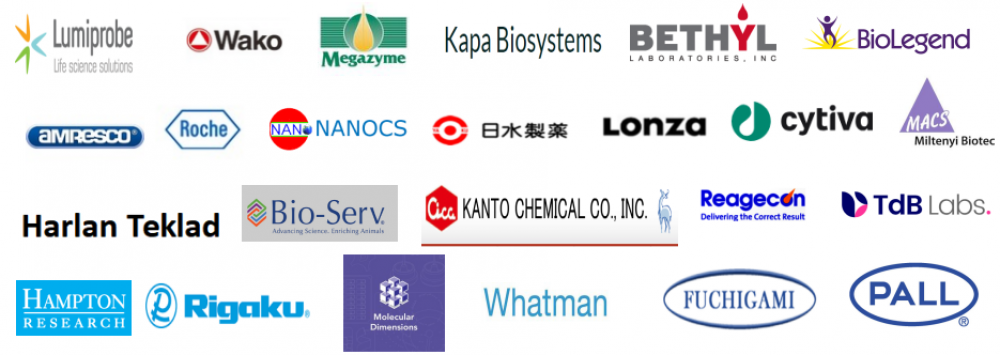Cell-Tracker Deep Red;Cell-Tracker Green CMFDA;Cell-Tracker Red CMTPX;Cell movement 细胞运动;Cell location 细胞定位;Cell Tracker dye 细胞示踪探针;
订购信息:
|
产品名称 |
产品编号 | 规格 | |
|
Cell-Tracker Deep Red 活细胞示踪探针(深红色) |
MX4110-30UG | 2×15µg | |
| Cell-Tracker Deep Red 活细胞示踪探针(深红色) | MX4110-75UG | 5×15µg |
|
| Cell-Tracker Deep Red 活细胞示踪探针(深红色) | MX4110-150UG | 10×15µg |
|
产品描述
Cell-Tracker荧光探针是用来监测细胞运动、定位、增殖、迁移、趋化和侵袭的优秀工具。
Cell-Tracker Deep Red,能自由穿透细胞膜进入细胞,在胞内转化生成不具细胞膜渗透性的反应产物。该产物几次传代都能良好的保留在活细胞。在细胞群内,染料只会转移到子代细胞,不会转移到邻近细胞。
Cell-Tracker Deep Red特地设计使其至少72h(典型有3~6代)能展示荧光,此染料表现出理想的示踪特征:稳定、工作浓度下无毒性、良好保留在细胞,且在生理pH下呈明亮荧光。另外,Cell-Tracker Deep Red的激发和发射光谱(630/650nm)与绿色荧光蛋白GFP、红色荧光蛋白RFP都能很好的分开,适用于多重标记(见附表1. Cell-Tracker荧光探针的光谱特征)。
产品特性
1) 同义名:CellTracker™ Deep Red Dye; CellTracker™ 深红色染料;
2) 分子量:698.3 g/mol
3) 外观:深蓝色固体
4) Ex/Em:630/650nm
5) 溶解性:溶于DMSO(1mM)
保存与运输方法
保存:-20℃避光干燥保存,至少2年有效。
运输:冰袋运输。
注意事项
- 荧光染料都存在淬灭的问题,保存和操作过程中注意避光。
- 避免使用含氨基和巯基的缓冲液。
- 为了您的安全和健康,请穿实验服并戴一次性手套操作。
应用示例
文献1)Sarah L. Richardson, Alzbeta Hulikova, Melanie Proven, Ria Hipkiss, Magbor Akanni, Noémi B. A. Roy, Pawel Swietach. Single-cell O2 exchange imaging shows that cytoplasmic diffusion is a dominant barrier to efficient gas transport in red blood cells.Proceedings of the National Academy of Sciences May 2020, 117 (18) 10067-10078; DOI: 10.1073/pnas.1916641117
Method (Single-Cell O2 Saturation Imaging):Blood was first diluted 200-fold in Ca2+-free Hepes-buffered Tyrode, and cells were loaded with a mixture of CellTracker Deep-Red (5 µM) and CellTracker Green (15 µM) in dimethyl sulfoxide (DMSO). For some experiments, cells were also loaded with SYTO45 (Invitrogen) at 1:1,000 dilution of 5 mM stock. After allowing 10 min for dye loading, cells were spun down, resuspended in Ca2+-containing solution, and plated on a poly-L-lysine pretreated Perspex superfusion chamber that was mounted on a Leica LCS confocal system. Cells were superfused with solutions at 23 °C or 37 °C. CellTracker Deep-Red and Green dyes were excited simultaneously by 488- and 633-nm laser lines, and fluorescence was acquired by two photomultiplier tubes at 500 to 550 and 650 to 700 nm at 7.8 Hz in bidirectional x–y scan mode (128 × 128 pixels) to maximize temporal resolution with pinhole at 4 Airy units to maximize signal to background ratio. Fluorescence was ratioed and normalized to starting ratio.
Fig. Measuring O2 exchange in RBCs using single-cell O2-saturating imaging. (C) Wild-type RBCs loaded with a mixture of Deep-Red and Green, showing fluorescence in oxygenated and deoxygenated microstreams. For these experiments, neither solution was fluorescently labeled. Grayscale ratio maps (Right) were calculated from these fluorescence maps (Left and Center). (D) On deoxygenation, Deep-Red fluorescence is reduced, whereas Green remains constant (wild-type RBCs; n = 356 cells).
文献2)Grote S, Ureña-Bailén G, Chan KC, et al. In Vitro Evaluation of CD276-CAR NK-92 Functionality, Migration and Invasion Potential in the Presence of Immune Inhibitory Factors of the Tumor Microenvironment. Cells. 2021;10(5):1020. Published 2021 Apr 26.
Method (Tracking of NK-92-Mediated Tumor Cell Invasion):NK-92 as well as CD276-CAR NK-92 cells were assessed for their invasion potential. (CD276-CAR) NK-92 cells were stained using CellTracker™ Deep Red dye according to the staining protocol provided by the manufacturer. Melanoma 3D spheroids were co-incubated with NK-92 cells at an E:T ratio of 5:1 and monitored using the Celigo S imaging cytometer (Nexcelom, Lawrence, MA, USA) at indicated time points over a period of 120 h.
Fig 2. GFP-transduced WM115 melanoma cells were grown as 3D spheroids and co-incubated with CellTracker™ Deep Red-labeled NK-92 or CD276-CAR NK-92 cells for 120 h. Representative fluorescence pictures of spheroids at indicated time points are shown (a).
使用方法
1.细胞准备
在合适的培养基内培养细胞。贴壁细胞可以在含盖玻片的培养皿内爬片生长,装入足量的生长培养基。
2.操作步骤
以下描述的是将染料加到培养细胞以及在荧光显微镜下成像的步骤。各种因素,比如将染料加载到细胞或组织,可能都需根据特定的细胞类型对某些条件做出修改。
探针的最佳染色浓度需根据用途来调整。建议刚开展实验需要测定至少1个10倍范围内的浓度。一般来说,长期染色(≥3天)或使用快速分裂的细胞需5-25µM的染料。对于短期实验(比如活力测定),使用低浓度染料(0.5-5µM)。由于Cell-Tracker Deep Red染料的荧光信号高,最佳使用浓度在250nM-1µM。为了维持正常的细胞形态和降低潜在的伪影,尽可能使用低浓度的染料。
2.1 制备Cell-Tracker染色工作液
① 开瓶前将产品从冰箱取出,放到室温使其回温至少20min。
② 用高质量的无水DMSO溶解粉末使其浓度为1mM。例如,每管15µg Cell-Tracker Deep Red(Mw: 698.3 g/mol)冻干粉,加入20µl DMSO充分溶解,即得到1mM(1000×)母液。
③ 用无血清培养基稀释母液到250nM-1µM的工作浓度(最佳浓度需优化)。预热染色工作液到37℃。
2.2 悬浮细胞染色步骤
① 离心收集细胞,吸掉上清液。用预热的Cell-Tracker染色工作液轻轻的重悬细胞。
② 在适合特定细胞类型的生长条件下避光孵育15-45min。
③ 离心细胞,吸掉Cell-Tracker染色工作液。
④ 加入选择的培养基,将标记好的细胞分配到载玻片或到选择的培养器皿内。
⑤ 根据附表1 选择合适激发和发射波长的滤片来进行成像检测。
2.3 贴壁细胞染色步骤
① 吸走培养基。
② 轻轻加入预热的Cell-Tracker染色工作液。
③ 在适合特定细胞类型的生长条件下避光孵育15-45min。
④ 吸掉Cell-Tracker染色工作液。
⑤ 加入选择的培养基。
⑥ 根据表1 选择合适激发和发射波长的滤片来进行成像检测。
3.荧光显微镜观察
Cell-Tracker荧光探针可用带标准光学和图像增强的各种落射荧光光学显微镜检测。根据染料选择合适的滤片。见附表1 Cell-Tracker荧光探针的光谱特征。
相关产品
| 货号 | 名称 | 规格 |
| MX4107-100UG | Cell-Tracker Green CMFDA 活细胞示踪探针(绿色) | 2×50μg |
| MX4108-100UG | Cell-Tracker Orange CMTMR 活细胞示踪探针(橙色) | 2×50μg |
| MX4109-100UG | Cell-Tracker Red CMTPX 活细胞示踪探针(红色) | 2×50μg |
| MX4110-30UG | Cell-Tracker Deep Red 活细胞示踪探针(深红色) | 2×15µg |
| MX4111-1Kit | Cell-Tracker Three-color Trial Kit (Green/Red/Deep red)
活细胞示踪三色组合试剂盒(绿色/红色/深红色) |
1kit |
| MX4101-1G | Fluorescein diacetate (FDA) 二乙酸荧光素 | 1g |
| MX4205-10MG | Propidium Iodide 碘化丙啶(粉末) | 10mg |
